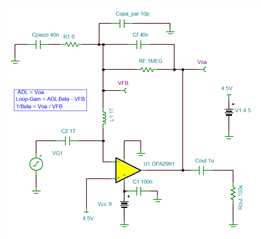Other Parts Discussed in Thread: OPA2991, TL072,
I'm trying to simulate a charge amplifier in LTSpice to be used with a piezoelectric sensor in audio range.
Here are the resources for charge amplifiers:
https://en.wikipedia.org/wiki/Charge_amplifier
Charge amplifier is basically an integrator. I modelled the piezo sensor as a voltage source with series capacitance. Gain of charge amplifier is determined only by the ratio of Cpiezo / Cf. I'm trying to use OPAx145 - latest SPICE model (rev. C) from TI product page.
Here's my schematic:

This means the amplifier has gain of Cpiezo / Cf = 40nF / 10nF = 4. With this setting, the output is correct, as follows:

However, when I change the Cf to 40nF, thus setting the gain to 40nF / 40nF = 1, this is the output I get:

By choosing different values of Cf, I discovered I'll get similar crazy outputs with Cf > 11nF, i.e. every time the gain is < 4.
However, if I change the Cpiezo to 4nF and Cf to 4nF, i.e. the gain of 1, but with lower capacitances, I get a correct result (100mV sine wave on output).
If I use old TL072 model instead of OPAx145, any values of Cf or Cpiezo seem to give normal (expected) results. Similarly with OPA2991 model (which is a CMOS opamp, so maybe not directly comparable). I also tried OPAx134 - expected results too.
I'm attaching my LTSpice project with opamp models.
What property of OPAx145 is causing this? Or is something wrong with my simulation? Thank you!










